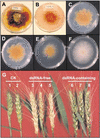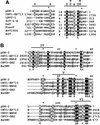Double-stranded RNA mycovirus from Fusarium graminearum
- PMID: 11976130
- PMCID: PMC127521
- DOI: 10.1128/AEM.68.5.2529-2534.2002
Double-stranded RNA mycovirus from Fusarium graminearum
Abstract
Double-stranded RNA (dsRNA) viruses in some fungi are associated with hypovirulence and have been used or proposed as biological control agents. We isolated 7.5-kb dsRNAs from 13 of 286 field strains of Fusarium graminearum isolated from maize in Korea. One of these strains, DK21, was examined in more detail. This strain had pronounced morphological changes, including reduction in mycelial growth, increased pigmentation, reduced virulence towards wheat, and decreased (60-fold) production of trichothecene mycotoxins. The presence or absence of the 7.5-kb dsRNA was correlated with the changes in pathogenicity and morphology. The dsRNA could be transferred to virus-free strains by hyphal fusion, and the recipient strain acquired the virus-associated phenotype of the donor strain. The dsRNA was transmitted to approximately 50% of the conidia, and only colonies resulting from conidia carrying the mycovirus had the virus-associated phenotype. Partial nucleotide sequences of the purified dsRNA identify an RNA-dependent RNA polymerase sequence and an ATP-dependent helicase that are closely related to those of Cryphonectria hypovirus and Barley yellow mosaic virus. Collectively, these results suggest that this dsRNA isolated from F. graminearum encodes traits for hypovirulence.
Figures




References
-
- Anagnostakis, S. L. 1987. Chestnut blight: the classical problem of an introduced pathogen. Mycologia 79:23-37.
-
- Anagnostakis, S. L. 1984. The mycelial biology of Endothia parasitica. I. Nuclear and cytoplasmic genes that determine morphology and virulence, p. 353-366. In D. H. Jennings and A. D. M. Rayner (ed.), The ecology and physiology of the fungal mycelium. Cambridge University Press, Cambridge, United Kingdom.
-
- Ann, I.-P., and Y.-H. Lee. 2001. A viral double-stranded RNA up regulates the fungal virulence of Nectria radicicola. Mol. Plant-Microbe Interact. 14:496-507. - PubMed
-
- Beardall, J. M., and J. D. Miller. 1994. Diseases in humans with mycotoxins as possible causes, p. 487-539. In J. D. Miller and H. L. Trenbolm (ed.), Mycotoxins in grain-compounds other than aflatoxin. Eagan Press, St. Paul, Minn.
-
- Bowden, R. L., and J. F. Leslie. 1992. Nitrate-nonutilizing mutants of Gibberella zeae (Fusarium graminearum) and their use in determining vegetative compatibility. Exp. Mycol. 16:308-315.
Publication types
MeSH terms
Substances
LinkOut - more resources
Full Text Sources
Other Literature Sources

